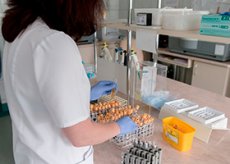Medical expert of the article
New publications
US scientists have created a new type of blood test for pregnancy
Last reviewed: 02.07.2025

All iLive content is medically reviewed or fact checked to ensure as much factual accuracy as possible.
We have strict sourcing guidelines and only link to reputable media sites, academic research institutions and, whenever possible, medically peer reviewed studies. Note that the numbers in parentheses ([1], [2], etc.) are clickable links to these studies.
If you feel that any of our content is inaccurate, out-of-date, or otherwise questionable, please select it and press Ctrl + Enter.

A new type of analysis can detect more than seven hundred different toxic substances in a woman’s blood that can harm the unborn child.
The high level of industry and the transport congestion of cities make living in some countries potentially dangerous to health. For example, in the United States, more than fifteen tons of chemical waste are produced per person per year. Considering that the economy continues to grow, the environmental problem is getting worse every year. And this is not surprising, because consumers are striving for greater household and material benefits.
The impact of industrial and household toxic substances on the body of a pregnant woman and on the development of the unborn child, unfortunately, has not been studied very well at the moment. Although doctors assume that serious genetic disorders, disorders of the endocrine and metabolic functions, hypoxia phenomena are to one degree or another associated with the impact of the external environment. Most countries already have regulated bans on the use of mercury compounds, arsenic, etc. However, few people know that every day any parent encounters other potentially dangerous substances that have simply not been sufficiently studied yet.
For example, can you answer questions like:
- What is the composition of your phone's body?
- What is the paint that children's toys are made of?
- Why does the bleaching agent not smell like chlorine, but has a rather pleasant aroma?
Have you ever thought about it? After all, many different chemical components are quietly introduced into our body and poison it. For example, doctors have recently discovered the endotoxic effect of phthalates, which are present in plastic and slowly destroy the endocrine system of children. Moreover, this property was discovered by accident. What can we say about other substances unfamiliar to us?
Moreover, the negative properties of many components are known, but manufacturers and higher authorities turn a blind eye to this. For example, toxic Bisphenol-A, which inhibits the functioning of female reproductive organs, is used in the composition of plastic for baby bottles.
Another substance, 1,4-dioxane, is used as an industrial solvent. According to the EPA, this component is a probable carcinogen, but it continues to be included in disposable cups. According to statistics, almost 30% of Americans receive a decent dose of dioxane daily by drinking coffee. However, federal standards for the content of this substance in products have not yet been determined.
It is precisely in order to detect such toxic substances in the blood of a pregnant woman that scientists have created a new blood test that will help prevent the negative impact of toxins on future generations. This innovative screening will be able to keep environmental risks under control and will also make it possible to take timely measures if any substance is found to be in excess of the permissible limit.
More details about the study can be found in Environmental Health Perspectives.


 [
[